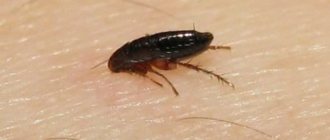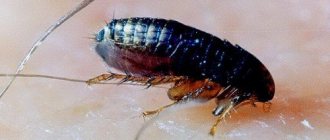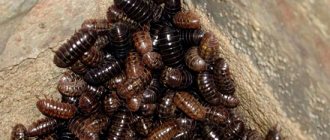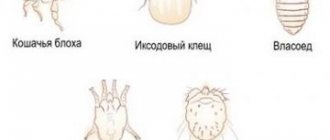Cat fleas are small brown insects that feed on the blood of animals and humans.
Many people, wondering whether cat fleas are transmitted and are harmful to humans, do not want to have pets. This is not surprising, since indoor bloodsuckers can be carriers of various diseases. But fleas do not live on the human body; it does not act as a favorable environment for production. Parasites use people only as food, but even so they can cause a lot of trouble.
To get rid of them, use anti-flea shampoos, sprays, drops or collars. The choice is based on the preferences of the owner, pet, and veterinarian recommendations.
Are they transmitted to humans?
Fleas are small, dark brown insects that feed on blood. Their body length does not exceed 3-4 mm. They move by jumping or running. A cat can be a carrier of any type of floor flea. More often she catches them while walking outside to avoid animals.
When wondering whether fleas from a cat can spread to the human body, one should clarify the fact that bloodsuckers do not live on people. Therefore, they cannot be transmitted from animals.
Parasites feed on the blood of warm-blooded creatures, which can include humans. But having received what they need, they leave. Fleas can live in a home, on pets, but not on the body of the owner of the house. At the same time, animals that have constant contact with humans can become infected from him if bloodsuckers are brought from the street with clothes and shoes.
When answering the question of whether cat fleas jump on humans, it should be taken into account that parasites move by crawling and jumping. The length of their jump can reach 30 cm. This is enough to move from the floor to the lower part of the victim’s body. That's why the legs are bitten more often. The arms, back and neck suffer if the animal sleeps on the bed with the owner, and the parasites can reach any area of the body.
What types of fleas pose a threat to humans?
These parasites have plagued humanity for many centuries. Previously, they were confused with lice. But lice live mainly on the head and groin and they are immobile. Fleas, on the contrary, choose the hairless part of the skin. And they are able to move at lightning speed.
Human fleas: what they look like and how to get rid of fleas on humans, read more in the article here.
There are about 2000 species of fleas in the world. Their Latin name comes from the mammal on which they primarily live. Absolutely all varieties of flea bloodsuckers are carriers of dangerous infectious diseases, so each of them poses a threat to human health.
This is interesting! If people developed the jumping abilities of fleas, they could jump to a height of 135 meters. And up to 260 meters in length.
Rat
Maximum danger! Fleas that live on rats carry a deadly disease called plague. Rat parasites are not just one specific type of parasite, but a whole range of them. Habitat: all types of small rodents.
By sight they cannot be distinguished from the others. Laboratory examination will be required for classification. In modern houses they are becoming less and less common, but in rural areas it is quite possible to encounter them.
Pests do not live on rats and mice; they only feed on their blood and waste residues. Their main habitat is rat holes. Therefore, in order to get rid of them you need to find these places.
Doggystyle
Habitat: dog fur or bedding. The eggs laid are spread over an impressive territory. Wingless blood-sucking – imago. Externally similar to a cat flea.
Read more about what fleas look like and how dangerous they are on dogs in this article.
Fleas are transmitted from dog to person, they jump on people, mainly affecting the lower limbs. Therefore, the risk of infection remains high.
Adult ectoparasites make up only 5% of all four stages of a flea colony. The bulk are larvae, pupae and eggs. Therefore, it is necessary to fight not only with parasites that were found on a pet.
Felines
A wingless arthropod that feeds on the blood of cats. Although they will not disdain dog blood. If there are rodents in the house, then the cat flea can live in their burrows.
The best products for killing cat fleas
When a person is bitten, the legs below the knees are mainly affected. Life expectancy is up to one and a half years. Like all species, adults go through four life stages:
- egg;
- larva;
- chrysalis;
- adult.
The bite is characterized by burning pain. An animal massively infected with this parasite may die from anemia.
They are carriers of dangerous infections: rickettsiosis, plague, brucellosis. Therefore, cat fleas are dangerous to humans. In addition, their saliva can provoke a severe allergic reaction.
Do they bite?
When wondering whether cat and dog fleas can bite a person, it is worth noting that bloodsuckers do not care what kind of blood they feed on. Insects live on pets, but can also gnaw their owners if there is not enough blood from the animal. This usually happens when there is a small kitten in the house. His body cannot saturate the horde of parasites, then the latter look for food elsewhere.
Interesting fact: cat fleas, unlike dog fleas, bite people more often. After purchasing a pet or before going to an area where pets roam, you should take measures to prevent bites. For animals, these can be collars, gels, sprays, and for humans, special repellent ointments.
Symptoms of fleas in humans
Surprisingly, not every owner of a furry pet is aware of the dangers of fleas to humans. An insect bite is quite painful. Due to the absence of a proboscis for sucking blood, the parasite practically bites into the surface of the skin.
Flea bites
On a note!
Any antiseptic will help get rid of the unpleasant itching after a flea bite.
After a few minutes, the bite site begins to turn red, severe itching and burning appear. Scratching results in red, inflamed spots. The most important thing is that with such contact there is a high probability of contracting a dangerous infection. Dermatitis, erythema, pulicosis, brucellosis, encephalitis, salmonellosis - these are the dangers of a flea bite for humans. And this is just part of the list; in total there are more than 100 diseases, many of which can be fatal.
The parasite's bite is also dangerous due to the occurrence of an allergic reaction, which is more often observed in children. Symptoms may include runny nose, dry cough, hives, dermatitis and itching.
Important!
The consequences of flea attacks are not only red bumps that cause aesthetic discomfort. A parasite bite can be deadly. Therefore, knowing how fleas are harmful to humans, it is necessary to begin the fight against them in a timely manner.
Symptoms of a human being bitten by a cat flea
On the human body, a cat flea bite is recognized by the following signs:
- Fleas, unlike bedbugs, can bite at any time of the day or night.
- Cat flea bites on a person’s body are located no more often than 2-3 cm apart from each other. They can be localized in the area of the arms, back, lower leg, and neck.
- Blisters form in the area of the bite. They swell and take a long time to heal.
- The area around the blister may be itchy and painful.
- The bite is painful because an enzyme in the saliva prevents blood from clotting.
With individual intolerance to the saliva of the parasite, some people, when fleas from cats or dogs are temporarily transmitted to a person, experience a severe allergic reaction.
In this case, antihistamines and ambulance are needed.
Are fleas dangerous for humans?
Fleas are insects that are not very particular about what they eat. They indiscriminately attack animals and birds. They will not disdain humans either.
The allergen is insect saliva. The human body can react to a bite in different ways. For some, it is a ten-minute itch, while for others, the whole complex of allergic reactions manifests itself.
A huge number of subspecies of worms carried by insects can cause a number of diseases. Many of which become chronic and are fraught with serious consequences for the body.
Danger to humans
When understanding the question of whether cat and dog fleas are dangerous for humans, it should be noted that the parasites themselves do not pose a threat to the victim. But if the insect has been in contact with an unhealthy animal and acts as a carrier of the disease, then when bitten, the infection can penetrate into the wound.
Therefore, concluding, doctors say that fleas living on a cat can be dangerous to humans, transmitting to them through the blood:
- Pulicosis.
- Dermatitis.
- Hepatitis.
- Typhus.
- Brucellosis.
- Salmonellosis.
- Encephalitis.
- Helminthiasis.
- Dipilidosis.
- Fever.
- Erythema.
In the Middle Ages, cat fleas caused a plague epidemic, which was dangerous for humans.
Nowadays, fleas rarely cause serious problems when they jump from cats to people. More often, patients suffer from helminthiasis; sometimes, due to intolerance, an individual severe allergic reaction occurs.
How are dog or cat fleas transmitted to humans?
The very word “transferred” does not quite accurately reflect the essence of what is happening. An attack from a bloodsucker will be more of a short-term act aimed at satisfying hunger, and nothing more. Fleas come to people for one single purpose. The bloodsucker has no other plans for the person and cannot have any. To lay eggs, insects need places with different physical conditions: it must be dark, humid and warm.
A well-fed parasite is completely indifferent to a person . He has other concerns, other locations: garbage heaps, dark corners, a resting place for a four-legged family member. But with the onset of hunger, the parasite again sets out in search of a warm-blooded donor, and whoever is unlucky: a cat or a person who ends up in the parasite’s field of smell and touch will become its victim. Even more sense of smell, since it is the smell that sets the direction for the little “vampire’s” jumps.
Of all the fleas that parasitize domestic animals, the cat variety is the most common. She, one might say, dominates her niche and fleas in cats are transmitted to humans and, accordingly, bite him most often. Even much more often than the human flea does. Dog fleas are transmitted to humans and bite them much less often.
Where is the danger of fleas transferring to humans from animals?
Most often, fleas spread to people from cats and dogs . But the source of bloodsuckers can also be rodents, such as mice and rats. However, this is rather an exception to the rule and pets still remain leaders in terms of the threat of infection. A person who finds himself near a doghouse is already a potential victim of parasites, because in such places the number of hungry insects is simply enormous.
Flea attacks can occur in other places:
- Heavily contaminated housing.
- In those natural landscapes where field mice usually live and where a person might find himself during a picnic. Having spread a blanket on the ground, a person does not even suspect that he has disturbed small rodents, whose holes are under the blanket. But the bloodsuckers certainly won’t forgive such a mistake and will try to drink the blood from the lovely vacationers.
- Agricultural livestock farms, including rabbit and fur farms . The workers of these farms find themselves under attack by jumping “vampires” for the simple reason that they multiply there exponentially, despite the measures taken against the parasites;
- The risk group includes those people who, due to the specifics of their professional activities (biologists, woodcutters, hunters), come into contact with carriers of parasites in their natural environment. For example, near a fox’s hole, hunters can be attacked by a mass of hungry bloodsuckers.
- Fleas often attack the inhabitants of dirty homes, where pests have already dominated for many years . These residents often want to find out whether fleas are transmitted to humans and how this happens.
- Parasites can enter a room with household appliances, furniture, clothing and then multiply there if decisive action is not taken after the first bites.
According to statistics, 25% of four-legged pets are carriers of ectoparasites, but only specialists can say what specific biological species they belong to.
The dangers of flea-borne pathogens
In itself, the transmission of fleas from a cat to a person with subsequent blood loss of the latter is not the most serious medical problem that awaits “blood donors.” Parasites have access to the fluid medium of the body - blood - which, through its flow, can spread pathogens that have entered it from the saliva of fleas throughout the body. A person is at risk of developing serious illnesses.
Rat fleas caused a plague epidemic in the history of Europe , when it lost a third of its population. Medieval Europe was not a model of cleanliness and hygiene, and fleas and rats were commonplace. The plague bacillus has not completely disappeared even today. It can “shoot” with a seemingly harmless flea bite. And it is found in the burrows of mouse-like rodents: voles, hamsters, jerboas, gerbils.
For the pumpkin tapeworm, the flea is an intermediate host . A person can become the final host of this dangerous parasite after being attacked by an infected bloodsucker.
Rarely, there may be a sand flea in the room . The female tries to penetrate a person’s skin and lay her eggs there. In humans, this leads to the appearance of long-term non-healing ulcers and wounds.
Can they live on humans?
When answering the question of whether fleas pass from cats and dogs to people, they definitely say that they do not stay on the body for long. Having bitten the owner, the bloodsuckers jump to the floor to further lay eggs. Basically, adult individuals parasitize animals and hide in the fur of pets; people do not have productive “vegetation,” which makes insects uncomfortable when attaching. Hence, some individuals suspect that cat fleas can live in human hair, which imitates animal fur. This is also incorrect, since the human body has a temperature of 36.6 C, and in animals this figure reaches 38-39 C, which significantly improves living conditions for pets.
Therefore, if there is any doubt whether cat fleas can live on humans, the answer is no. The appearance of blood-sucking parasites occurs near the location of the victim. A large number of fleas are found not only on the body, but also on animal rugs or floor carpets. If we talk about the street, then insects settle under leaves, stones, in garbage, and rodent burrows. By temperature fluctuations, vibrations, and smell, they determine the appearance of the victim, jumping onto it.
What type of insect can parasitize humans and are fleas transmitted from cats to humans?
Only one type of flea can parasitize a person, which can pass to him from any animal. This type of insect can live on rodents, horses, dogs, cats and other animals with which humans can come into contact very often. In the modern world, people are most often bitten by a flea that parasitizes a cat, since this is the most common pet. Insect infestation may also be due to the fact that human blood attracts fleas in the same way as cat or dog blood. However, it should be mentioned that insects will need some time to adapt to the new type of blood. Do not think that parasites can only settle in a house where regular cleaning is not carried out. This is far from true; fleas can appear in a completely clean room.
Dangerous diseases
Fleas on cats are dangerous because they can spread deadly diseases. In the last century, it was these insects, parasitizing rats, that became the spreaders of the plague.
You can potentially become infected from small parasites and their bites:
- encephalitis;
- tularemia;
- anthrax;
- bubonic plague;
- typhus;
- trypanosomiasis.
The likelihood of infection is reduced to a minimum. A person quickly forgets about the unpleasant incident with a flea attack and continues to live his life. However, the incubation period of some diseases lasts up to 2 months. Common signs of any dangerous disease are fever, intoxication, and weakness.
In such cases, you need to seek help from specialists. A dangerous disease diagnosed in its early stages responds well to treatment.
Interesting!
In exotic countries, the most dangerous are sand fleas, which get under the nail and live under the skin for several months. The female lays eggs in the body, and as the larvae grow, swelling increases on the surface of the skin. If there is a severe infestation of sand fleas, a person may lose motor ability.
Allergy to a bite, consequences
The question of why fleas are dangerous does not have a clear answer. They are carriers of a variety of infectious diseases that lead to negative consequences for the body. These are plague, pulicosis, problems with the condition of the skin, and so on.
A child under 12 years of age may be allergic to flea bites. But adults often encounter this phenomenon. The main symptoms of allergic reactions to parasites are as follows:
- body temperature increases to forty degrees;
- anxiety arises, breathing becomes difficult;
- fever appears;
- stomach upset occurs.
Often, a person experiences anaphylactic shock caused by enzymes that are part of the flea's saliva. If this happens, you should immediately seek help from a doctor. The doctor will diagnose the body, take tests and tell you how to cope with the problem.
Measures to prevent bites
Measures to prevent flea bites
To avoid troubles and health problems, it is necessary to take timely measures to destroy dangerous parasites.
- Pets should be treated with special flea medications between April and October. For these purposes, sprays, drops, collars, injection solutions, shampoos, tablets are produced, and folk remedies are used, the safest and most effective of which is tar soap. Products for treating dogs are different from products for removing fleas from cats.
- The apartment is treated for preventive purposes if there are animals in the house. To repel fleas, substances with a pungent odor are used - essential oils of plants, vinegar, ammonia. If the apartment is infected, it should be treated with insecticidal preparations. To get rid of fleas, use aerosols, sprays, concentrated solutions - Raptor, Butox, Deltsid.
Measures to destroy parasites in animals and in the house are carried out simultaneously to prevent mutual infection. It is imperative to treat the sleeping places of insects; the rugs are washed at high temperatures.










